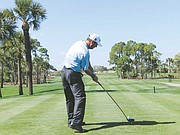The magic 15 inches of a golf swing
Golf Insider | Hagadone News Network | UPDATED 12 years, 5 months AGO
There's a bad idea floating around in golf instruction circles that goes like this: The obvious variations in swings that you see when you watch a golf tournament are simply styles. Tiger Woods' swing is different from Sergio Garcia's, and Luke Donald looks different from both of them, but they all are the same at impact. So, according to the argument, all you have to do is know what goes on at impact, then teach from impact backward - nothing else matters.
My opposition to this idea is not a quibble of words - a teacher must be exact when describing to a student what impact is. And if the message is that there are several things that all good players do the same, I would agree. But to say that all good players are the same (which this swing method believes to be true), then it is just plain wrong.
This obsession with impact has a number of serious flaws. For one, it's bad teaching that leads to bad learning. But let me assure you, the golf premise is also incorrect: All good golfers are NOT the same at impact.
Some great players fade the ball, some draw it and some hit it straight. Some hit it high, some low, some with a medium trajectory. And many of the very best players work the ball - low with a hook, high with a draw, medium with a fade. All of which means they change the impact as necessary.
Thus, the same player is different depending on the shot, because for each ball flight, a specific geometry is necessary at impact. To fade the ball, the face is open to the path; to draw the ball, it's closed; and the face is square to the path for a straight shot.
To be a good player, the swing must be "something-to-nothing": During your preshot routine and at address, you set the stage for the shot by arranging your body and clubface, and then use the practice swing to cue up your motor template (the "something"). Then you do nothing but follow the template. This is why I call what you do in the 15 inches between your heels at address the "magic 15 inches."
In the photos to the left are two tour pros playing the same hole at the same time. While there are some similarities, they are very different at impact because one draws the ball and the other fades it.
ARTICLES BY GOLF INSIDER

How to make a mental map
Golfers gather plenty of information about where the ball is, but not many collect enough information about where the target is. It's ironic that in a game where hitting the target is all that matters, many golfers hardly give the target a glance.

The magic 15 inches of a golf swing
There's a bad idea floating around in golf instruction circles that goes like this: The obvious variations in swings that you see when you watch a golf tournament are simply styles. Tiger Woods' swing is different from Sergio Garcia's, and Luke Donald looks different from both of them, but they all are the same at impact. So, according to the argument, all you have to do is know what goes on at impact, then teach from impact backward - nothing else matters.

Keep thy width in rotation
Many elements of the golf swing create power. The length, the speed and the solidness of contact are three, but also on the list is one you don't hear much about: width. When you extend your hands as far as possible away from the center of rotation during the swing, you increase the mechanical advantage of the system, and that spells more power.



